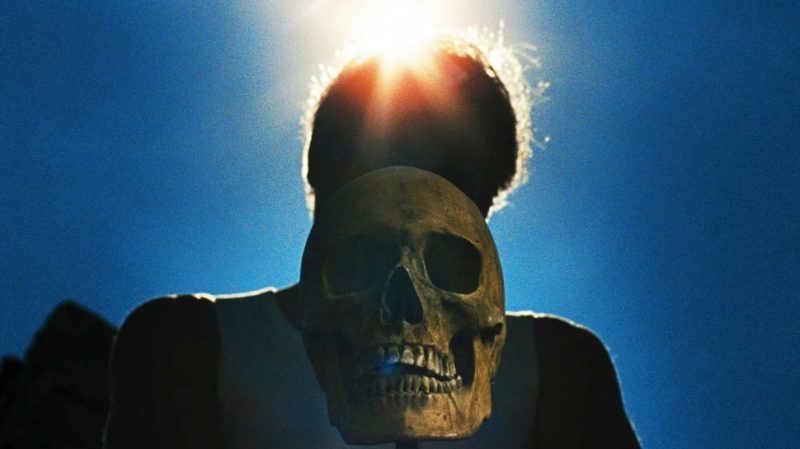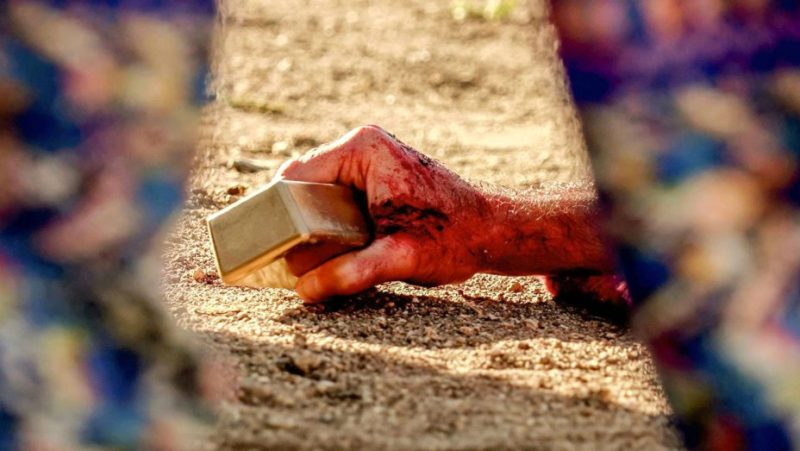
Hélène Cattet and Bruno Forzani know how people describe their work — and they’re not necessarily in agreement.
“They’re not homages!” says Cattet.
“The visual style borrows from classic Italian genre cinema — that’s the universe — but there’s a lot beyond that,” says Forzani. “Like our other movies, we’re borrowing a type of cinematic grammar. We work in genre and genre has codes. We use those codes to talk about certain things. Some people stop at the codes.”
“They consider it an accumulation of codes, at best,” says Cattet.
“Sure, there’s a lot of codes going on, but the movie is about something,” says Forzani.
Like their previous films Amer and The Strange Color of Your Body’s Tears, Let the Corpses Tan is firmly entrenched in the visual language of Italian genre films. While the first two turned trippy giallo imagery into a psychedelic trip, their latest casts a post-modern eye to the visual language of Eurocrime cinema of the 1970s. Based on a novel by Jean-Patrick Manchette and Jean-Pierre Bastid, it centres around a remote country home inhabited by a series of misfits led by Luce (Elina Lowensohn), who seems as much a den mother as she does the leader of the crime ring. The film’s events tend to push her towards the latter as a shipment of gold is intercepted somewhere in the hills; it makes its way to Luce’s home, bringing with it tons of undesirables with a desire to get in on the loot.
Speaking with Forzani and Cattet, I was finding it difficult to verbalize exactly how the film differs from the norm. I thought that if I had seen and loved Let the Corpses Tan at age 15 (precisely the age at which one should see these kinds of movies, ideally), I would likely have gone out and tried to find the movies that inspired it — and likely been disappointed by something like Mario Bava’s Rabid Dogs, which has the visual language but not the pace or energy of their film.
“It’s funny you mention being 15,” says Cattet. “We were interviewed by people who were in their early 20s. They said, ‘Oh, I was 15 when Amer came out!’ At the time, she said all people would talk about were the references that were all over the film, but when she was 15, she hadn’t seen any of those movies anyway — and she didn’t care to! Her reference for that visual language was the movie we’d made. For some people, I think it was reassuring to glom on to references they already knew, but in her case, it was about the story that was told and the way it was told that she was drawn to.”
“We’ve also spoken to people who discovered giallo through Amer,” says Forzani. “They thought that’s what giallo was like, and when they saw the real one, they couldn’t help but be disappointed. They saw the whole whodunit angle and thought, ‘Oh, this is it?’ (laughs)”
“What we do is utilize the iconography of 1970s Italian cinema — giallo, Westerns, whatever,” continues Cattet. “This was a very mise-en-scène-heavy type of cinema, where directors were extremely creative when it came to the mise-en-scène.”
“That’s the product, really,” adds Forzani. “That’s what they’re putting forth, rather than a commercial product.”
“What I love about that type of cinema is that it really uses all of the cinematic tools,” says Cattet. “What we did, and what I like, is to explore the use of cinematic matter as a language. Bruno is the one who introduced me to this type of cinema and we met in the middle, so to speak. The goal is to tell a story without holding the viewer’s hand and explaining everything through didactic dialogue. We’re not interested in that as viewers, ourselves. As directors, we write the movie with images, sounds and everything else that’s in the palette. Each shot in the movie was chosen as if it was a word. Placing them together creates cinematic phrases that tell a story.”
“It’s not ornamental, it’s visceral,” says Forzani. “Form is not just aesthetic, aesthetics are the vocabulary.”

Let the Corpses Tan trades in images: bright red blood, extreme close-ups on sweaty brows, the horizon deformed by the heat rising off the ground. By recontextualizing images that we’ve seen thousands of times within a basic narrative framework of a crime film we’ve seen just as many times, Forzani and Catet are developing a language of their own.
“It’s really something from giallo, or from Antonioni’s Blow-Up; there’s more than one way to read an image,” says Forzani. “Hélène was saying that one shot is a word. When you look at a word, you might see the shapes that form the letters that form the word, but unless you see them all together, they don’t make sense. With this movie, we met some Italian moviegoers who were our age or maybe older who had grown up with the language of this cinema, and to them, this was like rediscovering the feelings they had at the time. They weren’t seeing something they’d seen before, but they were re-living that feeling, like Proust and his madeleines, in a way. That’s also part of our approach. We don’t consider what we do to be homages. When we read the novel, we saw it as a Western — it’s a super Western concept, this siege movie. But once we decided that, we didn’t sit down and say, ‘This shot will be from this movie’ and ‘that shot will look like this type of shot.’ We saw it more as going back and finding the pleasure we had as viewers watching Westerns and recreating it our way.”
Suffice to say that a Cattet & Forzani screenplay might not look like what you expect from the form. Even close-ups — of blood, of piss, of fingers on triggers — have to be very carefully shot and prepared.
“We write sequences with images and sounds,” says Forzani.
“Every shot means something, like I said earlier, and so everything has to be prepared down to the very last detail,” says Cattet. “We can’t improvise. We can’t just show up on set and see what we’re working with. In this movie, doubly so — we have action scenes and stuff with special effects, which we hadn’t worked with before. We couldn’t just show up there, set up four cameras and tell ourselves we’ll catch what we can. There’s a point of view in every shot.”
“That also means nothing gets cut out,” says Forzani. “We don’t cut out any shots.”
“Everything we storyboarded makes it in!” says Cattet. “The editing is already pretty much done.”
“Editing helps us shape the pacing and the performances, but everything else is done,” adds Forzani.
As you can imagine, this kind of rigidity doesn’t make it easier to direct actors, not all of whom necessarily work in a way that makes this precision easier for them, either.
“In this case, we had a group of actors and they really got along,” says Cattet. “I don’t know if they decided this as a group or what, but they just let go. They trusted us and they had fun. Maybe because we’d already made two movies, so they had faith in us. In the past, some actors had had trouble with it. They felt like props, I guess. But you would certainly feel like a prop if you weren’t doing a character justice or inhabiting them properly. It’s certainly more rigid in our case, but the work is the same. The camera doesn’t follow the actor — the actor has to follow the camera.” ■
Let the Corpses Tan opens at Cinéma du Parc on Friday, Sept. 21. Watch the trailer here:

